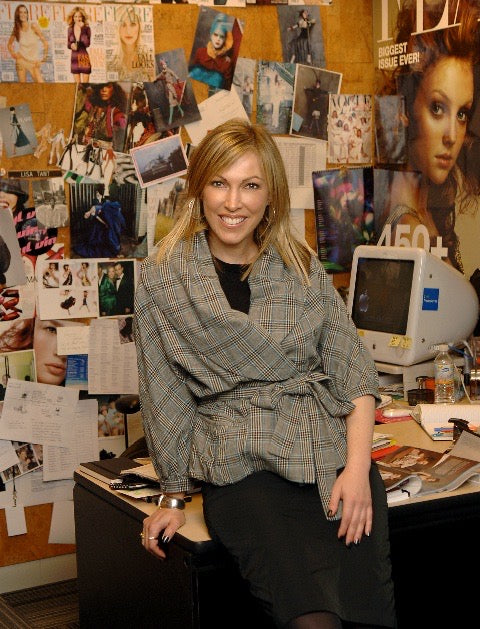Shaping the Fashion Industry from Within: Canadian Fashion Doyenne Lisa Tant on Mentorship, Personal Style, Career Evolution, and an Unforgettable Encounter with Karl Lagerfeld
Posted by BETTINA MUELLER REICHL

Lisa Tant at Flare Magazine - Photo by George Pimentel
By the time I began shaping Cape de Coeur’s tone of voice, visual identity, and was deep in the design and development of our signature capes, I realized I needed a mentor—someone I could turn to for honest feedback, clarity, and encouragement. Building a brand from the ground up, especially without a pre-existing blueprint, can be both creatively exhilarating and overwhelmingly uncertain.
I knew I was looking for someone with deep industry experience, exceptional taste, and a willingness to listen and share wisdom generously. When I first met Lisa Tant through a mutual friend, I was instantly drawn in—not only by her iconic background in Canadian fashion but by her warmth, authenticity, and generosity. She defied every stereotype I had imagined about high-profile magazine editors. I might have expected a “Devil Wears Prada” moment, but instead I met one of the kindest, most open-hearted and supportive leaders I’ve ever encountered—who, over time, became a dear friend.
In this special interview, Lisa opens up about her personal and professional journey through fashion, the evolution of media, her signature style philosophy, and the importance of supporting independent brands like ours. Her insights are as refreshing as they are wise—and I’m so excited to share them with our community.
Bettina Mueller Reichl, Creative Director & Founder
Your career has spanned influential roles—from your time at Chatelaine, to serving as Editor-in-Chief of Flare Magazine, and later as VP of Exclusive Services at Holt Renfrew and Styling Sales Director for Nordstrom Canada. Looking back, what moments or achievements stand out as defining in your journey?
I’m so grateful to have been the Editor-in-Chief of a fashion magazine during the golden age of publishing. In my tenure of nine years, we won multiple National Fashion Magazine Awards for editorial quality. I was proud of the team and our global contributors, and the many “firsts” we scored including first fashion magazine covers for emerging talent such as Lady Gaga and Jennifer Lawrence. Our readers were really engaged and I feel like we made a positive impact in their lives. It was such a privilege to lead the brand, and the highlight of my career.
You’ve witnessed firsthand the transformation of fashion media—from glossy print pages to digital feeds. How do you view the current landscape of fashion journalism, and where do you believe it's headed in an age of algorithms, influencers, and instant content?
When I left Flare in 2017, the magazine was the top selling fashion magazine in Canada - issues were thick with advertising and the brand was recognized internationally. The industry quickly fell apart with the onslaught of digital platforms that traditional media companies were slow to embrace. I struggled to get Flare the resources to compete. The executive team of the media division didn’t understand or value the brand. They were more focused on the sports and news titles. If they had vision and an innovative mindset, I believe the publishing division would have had a much longer run.
Today, I have a subscription to Apple News so I skim a handful of print fashion magazines online. However, I’m not all that interested in them. They’ve become advertising vehicles and I don’t relate to much of the editorial. I’m much more interested in Instagram with its instant gratification and individual real style. Anyone creative - regardless of age, size and cultural background - now has a platform to shine. By choosing those accounts, I can create my own digital lookbook that inspires me.
Throughout your career, you’ve been known for a polished and expressive sense of style. How has your personal aesthetic evolved over time, and how does cultivating an ageless style influence what fashion means to you today?
In my 20s, I was obsessed with fashion and tried every trend possible. When Linda Evangelista chopped her hair into baby bangs, I got them too. But I quickly matured out of that phase and became more interested in the stories behind the fashion scene. I couldn’t care less about personally wearing the hottest colour of the season. I’m more fascinated with why it became popular. Is it reflecting a social event (the Olympics for example)? A certain culture or celebrity? Who propelled that trend forward?
My style hasn’t changed in the past decade. I found a look that I love that reflects me and my values. It’s colourful, patterned and textured with shots of embellishment and shine. I want to be viewed as fashionable and accessible, creative but not costumey. I mix high and low brands in a more casual yet still impactful way. Everything I buy - from Lululemon to COS to Dries Van Noten - has to fit that look. I don’t buy on impulse and I don’t waste my money.
Can you share who your favorite designer is—and what it is about their work or philosophy that resonates most deeply with you?
I love to experiment with different looks but I found my true style when I attended my first Dries Van Noten runway show during Paris Fashion Week. I love his eclectic global prints, embellishments and trend-free pieces. I collect his work and his patterned toppers have become my signature look. I’m always hunting for new ones. His store in Paris is always my first stop when I’m off the plane. Everything else I buy has to relate back to that aesthetic - the colour, the pattern, the embellishment - feels like an eclectic exotic artistic look at life. I’m hopeful that the brand’s new creative director, Julian Klausner, will continue that same direction.
For aspiring creatives and editors, what guidance would you offer when it comes to building a meaningful career in fashion?
And more broadly—what’s your advice for staying resilient, embracing change, seizing unexpected opportunities, and navigating both setbacks and success with grace?
The fashion industry has changed so much in the past decade but people will always want to express their style. Curiosity is your biggest asset. I always recommend starting in retail as it helps one understand every aspect of why consumers buy. So many people don’t want to go that route, but if you don’t understand your “customer”, you’ll never succeed.
Create a digital signature that expresses your values and style. It’s how people network and was tremendously valuable to me when I moved into retail. I’ve crafted a personal brand that is accessible, friendly and curious.
More fashion brands are turning to AI-generated images in their campaigns—replacing traditional photography with faster, more cost-efficient tools. How do you feel about this shift?
Do you believe AI will dominate fashion visuals, or will people eventually crave the imperfect beauty of human-made imagery? Could working with real models and photographers soon become a new form of luxury?
While I appreciate the artistry behind AI, I hate how it’s impacting fashion. I spent my publishing career working with the most creative minds from stylists and makeup artists to photographers and models. Their energy, creativity and passion cannot be traded in for one person and a laptop. Unfortunately, because of budgets, AI will flourish, but it will never replace the synergy of a creative team.
You’ve crossed paths with countless fashion and music icons throughout your career—from runway legends to pop culture powerhouses. Is there one encounter that stands out as especially remarkable? What made that moment unforgettable?
I have been fortunate to interview some fascinating people. Karl Lagerfeld stands out. After his destination resort shows (Cannes, Venice, Miami), I would wait by the backstage exit after the show to chat. He had a short fuse and snapped fast if he was asked a dumb question. He loved to engage with someone who noticed details such as a shoe heel that reflected a Venetian gondola shape. His comments could be brutal and he flustered his PR team and minders. One time, they were trying to prevent me from asking Karl more questions. He leaned in and said (in a loud stage whisper) - “ignore them, I always do.” He delighted in being naughty and he was a brilliant fun person to interview.
Our founder and creative director, Bettina Mueller Reichl, first met you through a mutual friend—at a time when she was shaping the early vision for Cape de Coeur. Your generous guidance and industry introductions were instrumental in helping bring the brand to life.
From your perspective, what should consumers look for in an emerging brand today—and why is it so important to champion independent fashion voices?
The fashion industry is incredibly tough to crack. The average consumer sees the most value in brands that they recognize. Only the status logo of a major designer brand will crack open their wallet. I always advise emerging brands to have a clear concise point of view. What are you offering that’s different? What is missing from your customer’s wardrobe? Do you know exactly who she is? Young designers making glamorous gowns for women aged 18 to 35 are almost always on a one way ticket to nowhere. Designers who ignore business advice are right behind.
An emerging brand needs to look at every side of business. These are essentials: financing to support a sample line (for example); a clear view of the customer; a reliable production plan; a savvy social media approach; and so much more.
A heartfelt thank you to Lisa for sharing her time, her story, and her singular perspective with such candor and grace. Her career continues to inspire, not only through her accomplishments but through the integrity and generosity with which she uplift others. We are deeply grateful for her enduring support—and honored to share Lisa's voice with our community.

